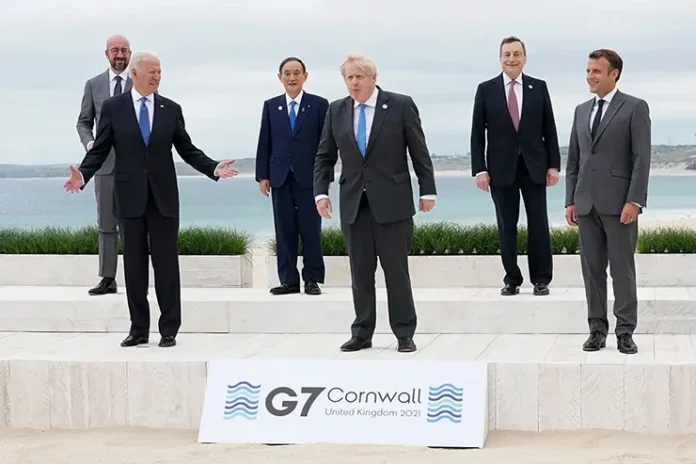As an invitee to the just concluded G7 Summit in Germany, India stood its ground on the Ukraine war. Despite some indirect pressure from the West and the US, Prime Minister Narendra Modi refused to condemn Russia, instead he called for immediate cessation of hostilities and resolution of the conflict through diplomatic means. In all, political narrative at the G7 Summit moved around Russia and China.
Yet buzz was created over the G7 leaders’ pledge to create a $600 billion fund under the banner of Partnership for Global Infrastructure and Investment’(PGII) over the period of five years. Indeed, an ambitious initiative, the fund under PGII will be used to counter China’s Belt and Road Initiative.
In fact, for the G7 countries, Sri Lanka’s worst financial crisis presented a frightening example of China’s debt trap mechanism camouflaged under Belt and Road Initiative. Pakistan, it is apprehended, is going to be the next victim of China’s multi-billion BRI in South Asia.
The list of victims of China’s opaque strategic infrastructure development programme under BRI will increase in days to come and most of those who would face the risk of debt trap would be smaller countries from the democratic world. It has served as a warning to America and its partners from Europe, Asia and Africa as they have felt that before time if economically vulnerable countries are not saved from China’s pernicious designs, they will be held responsible for the disastrous consequences of Beijing’s global ambition.
In this background, decision by G7 countries to mobilise $600 billion over the next five years to fund development of physical and digital infrastructure, health and fighting climate change in small, poor and vulnerable countries assumed a high significance. But then US President also clarified that PGII will not be an aid or charity, it will allow countries to “see the concrete benefits of partnering with democracies,” Biden said.
Since it is a huge fund, it will be mobilised collectively by the G7 countries for investments in critical infrastructure, health and tackling climate change. While the US has committed to mobilise $200 billion for the initiative over the next five years, Europe will mobilise $317.28 billion over the period and the rest will come from multilateral development banks, development finance institutions, sovereign wealth funds and others. Earlier at the Quad Leaders’ Summit in Japan on May 24, the informal group had pledged $50 billion in infrastructure aid and investment in the Indo-Pacific region over the next five years.
Meaning is clear, the democratic countries led by the US are in no mood to remain in wait and watch position when one after another small country in the world are staring at Sri Lanka like a financial crisis and for this, China’s opaque dealings under BRI is held responsible. Remember the initiative is already suspected as an instrument of China’s ambition to become a global power. Japan’s 2019 White Paper highlighted the concern that BRI infrastructure projects are facilitating the expansion of the People’s Liberation Army into the Indian and Pacific Oceans, Africa and Europe.
After the Sri Lankan economic crisis and Pakistan’s deepening economic problem, several countries which joined BRI, have started reviewing their decision to go along with the China-led initiative. In fact, the 2013 launched initiative which aims to recapture the ancient Silk Road and expand China’s influence is seen as a dangerous mechanism to push a country into debt traps.

Upset China has termed it propaganda. “To call the BRI a debt trap is a false narrative. For nine years since its inception, the BRI has followed the principle of extensive consultation, joint contribution and shared benefits and delivered tangible benefits to partner countries and their people,” Chinese Foreign Ministry Spokesperson Zhao Lijian said in response to a media query on June 27.
But AidData, an international development body at William & Mary University in the US, has refuted such claims of China. First of all, it said that half of China’s lending to developing countries for infrastructure development under the BRI scheme is not reported in official debt statistics. Secondly, it is said that Chinese lending is often kept off government balance sheets, directed to state-owned companies and banks, joint ventures or private institutions, rather than directly from government to government. If this international development body is to be believed, there are more than 40 low and middle-income countries from Asia to Africa to Europe whose debt exposure to Chinese lenders is more than 10 per cent of the size of their GDP.
There are countries like Laos, Zambia, Djibouti and Kyrgyzstan whose debt to China under the BRI is 20 percent of their annual GDP. In sync with its avaricious design, China lends at higher interest rates in comparison to the World Bank or the IMF or individual countries like Japan, Germany and France. China provides loans at 4 percent interest rate and also, the required repayment period is shorter–around 10 years, compared to around 28 years of Western countries and others.
Nonetheless, by the end of 2020, as per a BBC report, China’s loans to lower and middle-income countries including Pakistan had reached $170 billion. The British broadcaster further said that much of the debt owed by these countries to China relates to big infrastructure projects like ports, railways and roads.
However, with this, it is also feared that the PGII will, apart from increasing competition with BRI, exacerbate clashes between democracy and communism. Yet the larger question is: Will PGII be able to checkmate China’s ambition to be a global superpower? Will PGII be a true alternative to BRI? Because, unlike BRI being a state-back initiative, the proposed funding for PGII will largely depend on private companies. Therefore, will private companies commit such massive investments in infrastructure projects—is in the realm of speculation.
–The writer is a senior journalist with wide experience in covering international affairs. The views expressed are of the writer and do not necessarily reflect the views of Raksha Anirveda
–The writer is a senior journalist with wide experience in covering international affairs. The views expressed are of the writer and do not necessarily reflect the views of Raksha Anirveda














